| C H A P T E R 4 |
|
Maintaining the Sun Fire V40z Server |
This chapter describes how to add, replace, and configure components in the Sun Fire V40z server after it has been set up. For instructions on maintaining the Sun Fire V20z server, see Chapter 3.
This chapter contains the following sections:
To identify and isolate a faulty component, refer to the Sun Fire V20z and Sun Fire V40z Servers--Troubleshooting Techniques and Diagnostics Guide.
Perform this procedure to observe safety guidelines when you are powering off the system and removing the cover for a maintenance procedure in this chapter.
1. If the system OS is running, perform a shutdown of the OS.
2. Turn off all peripheral devices connected to the system.
3. Disconnect all AC power cords from the rear panel of the server (see FIGURE 1-5).
4. Label and disconnect all peripheral cables and all telecommunication lines connected to I/O connectors or ports on the back panel of the system.

|
Caution - The system’s printed circuit boards and hard disk drives contain components that are extremely sensitive to static electricity. |
5. Before handling components, attach a wrist strap to a chassis ground (any unpainted metal surface).
6. Loosen the captive screw on the cover latch, then rotate the latch toward the system rear to push back the cover (see FIGURE 4-1).
7. Lift up the cover and remove it from the server.
FIGURE 4-1 Removing the Cover From the Sun Fire V40z Server
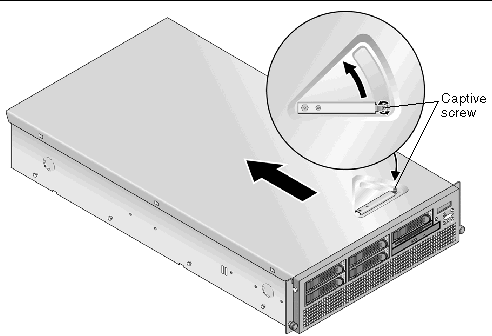
Before installing the Sun Fire V40z system cover, follow these guidelines:
Follow this procedure to install the system cover:
1. Guide the sides of the cover into the grooves on either side of the chassis.
2. Lower the front end of the cover and ensure that the sides engage fully down into the grooves.
3. Rotate the lever clockwise until the cover latches in place.
4. Secure the fastener to lock the lever in place.
Refer to the top-down view of the server in FIGURE 4-2 to locate components before performing the remove and replace procedures.
FIGURE 4-2 Locations of System Components in the Sun Fire V40z Server, Top-Down View
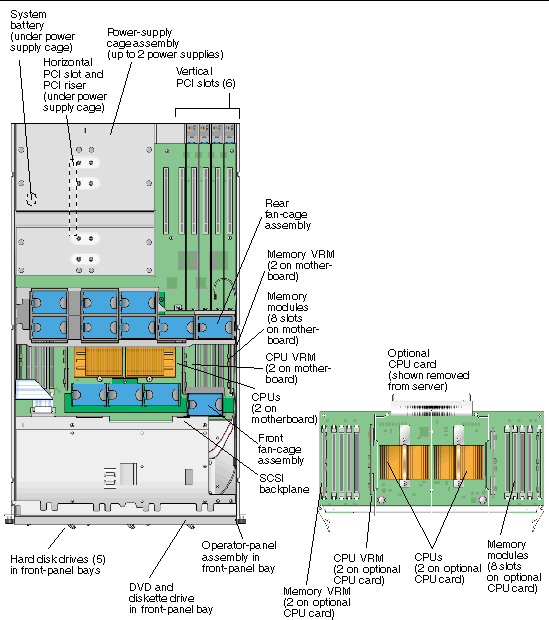
The ID assignments for the SCSI hard disk drive connectors (HDD) on the SCSI backplane are shown in FIGURE 4-3, when viewing the HDDs from the front of the server.
FIGURE 4-3 SCSI Slot Numbering for HDDs
If you have a single SCSI HDD, the drive can be inserted in either slot. If you have two or more HDDs, the drive with the OS boot sector must be installed in the lowest-numbered slot among the populated slots.
The Solaris boot disk must be installed in SCSI slot 0.
The information in this section applies to:
The following sections highlight some issues that you should take into account when performing the remove and replace procedures in this chapter.
An updated version of the Sun Fire V40z server has been released. Due to changes on the motherboard as well as in the BIOS and firmware, a number of components--such as memory VRMs and CPU VRMs--are not interchangeable between the original and updated releases.
The chassis part number (PN) is labeled on the front panel of the server, near the DVD-ROM/diskette drive assembly.
TABLE 4-1 explains the components available for each of the server releases.
If you replace a CPU, note that a minimum BIOS level is required as shown in TABLE 4-1. The CRU or FRU might not have the minimum BIOS level so check the product download site for the applicable BIOS.
If you want to install the Solaris 9 Operating System (OS) on an updated release of the Sun Fire V20z server (either chassis PN 380-1168 or PN 380-1194), you must download a Solaris OS Install-Time Update (ITU) from the web site. This ITU is required during OS installation.
If you want to install the Solaris 9 OS on an updated release of the Sun Fire V40z server, you must also download this Solaris OS ITU from the web site. This ITU is required during OS installation.
The Solaris OS ITU is available from the product web site:
http://www.sun.com/servers/entry/v40z/downloads.html
Two different versions of the Sun Fire V40z server have been released with CPUs of different stepping versions.
If you order a CPU to add or replace a CPU in your server, do not mix CPUs of different stepping versions.

|
Caution - A new heat sink ships with the stepping version “E” CPU. Ensure that you do not use an old heat sink on a stepping version “E” CPU. |
Before ordering a new or replacement CPU, verify the stepping version of your CPU(s) and then order the same stepping version.
Due to the power requirements and height restrictions, the stepping version “E” CPUs work only in the Sun Fire V40z server release PN 380-1206.
In a two or four CPU configuration of the Sun Fire V40z server, all CPUs must be the same stepping version and the same speed.
You can verify the stepping version of the CPU in a local server or on a remote server.
To verify the stepping version of your CPU(s) in a local server (with keyboard, video, and mouse attached):
1. Power on or reboot your server.
A message similar to the following example appears on the screen, and the memory test begins.
This sample shows the output for a Sun Fire V40z server.
----------------- PhoenixBIOS 4.0 Release 6.0 Copyright 1985-2002 Phoenix Technologies Ltd. All Rights Reserved Production RELEASE: System BIOS Revision = V2.33.5.2 SP Interface (PRS) Revision = 12 SP - BIOS Interface Active xxxxxxxxxxxxxxxxxxxxxxxxxx xx Sun Microsystems xx xx Sun Fire V40z xx xxxxxxxxxxxxxxxxxxxxxxxxxx CPU = AMD Opteron(tm) Processor 850 4 Processors Detected, CG - CG - CG - CG 7743M System RAM Passed 1024K Cache SRAM Passed ATAPI CD-ROM: CD-224E Mouse initialized -------------------------
2. During the memory test, press the Pause key.
3. Verify the stepping version of the CPUs in the line similar to the following examples:
2 Processors Detected, CG - CG
2 Processors Detected, E4 - E4
4. To continue with the reboot, press any key.
To verify the stepping version of your CPU(s) in a remote server:
1. Enable the Serial-Over-LAN (SOL) feature on the SP.
For more information, refer to the “Serial Over LAN” section in Chapter 4 of the Sun Fire V20z and Sun Fire V40z Servers--Server Management Guide.
2. Launch the SOL session from a SP command-line interface (CLI) to connect to the platform console remotely.
3. Type the following command:
platform set console -s sp -e -S baud rate
Where baud rate is the value that you have set in the BIOS settings; the default baud rate in the BIOS settings is 9600.
For example, if the baud rate in your BIOS settings is set to the default value, you would type:
platform set console -s sp -e -S 9600
| Note - This command changes the baud-rate value for the SP so that it matches the baud rate in the BIOS settings. It does not change the baud rate in the BIOS settings. |
4. Type the following command:
5. Verify that the correct baud rate appears in the Speed column.
Using the example above, the output should appear as follows:
Rear Panel Console Redirection Speed Pruning Log Trigger SP Console Enabled 9600 No 244 KB
6. Activate the SOL session by typing the following command:
7. Create another SP session from the SP prompt.
8. Recycle the power on the platform OS by typing the following command:
| Note - Before you recycle the power, ensure that the platform OS has been shut down gracefully, or that the file system has been synchronized using the sync command. |
platform set power state cycle -W -f
9. In the SP SOL session that you launched in Step 1, you now see the output of the BIOS CPU step screen.
For a sample of this output, see Step 1 in the previous procedure, Verifying the Stepping Version in a Local Server.
10. During the server’s memory self-test, terminate the remote session in order to pause the screen:
11. Verify the stepping version of the CPUs in the line similar to the following examples:
2 Processors Detected, CG - CG
2 Processors Detected, E4 - E4

|
Caution - The auxiliary CPU card is not a hot-swappable component. You must power down the server before removing the card. |
The following components are customer-replaceable units (CRUs):
| Note - If a CRU needs replacement, you can request a replacement part from Sun. All parts replaced under warranty must be returned to Sun within 30 days of receipt of the replacement part. |

|
Caution - Do not use +5V PCI cards or you might damage the motherboard. Use only +3V PCI cards in your Sun Fire V40z server. |
For information about how to resolve PCI and PCI-X hot-plug problems, see the Sun Fire V20z and Sun Fire V40z Servers--Troubleshooting Techniques and Diagnostics Guide.
For the current list of PCI cards that are supported for the Sun Fire V20z and Sun Fire V40z servers, visit http://www.sun.com/servers/entry/v40z/optioncards.html.
This page also contains links to third-party web sites for further information on each of the cards.
The following procedures describe how to add or replace a PCI card. The seven PCI card slots comprise four different types of slots on the Sun Fire V40z server (see FIGURE 4-4):
| Note - Each slot is capable of providing 25 watts maximum power. |
On the updated release (chassis PN 380-1206) of the Sun Fire V40z server, a plastic air-baffle cage has been added around the vertical PCI slots and is attached to the motherboard by four screws. When adding or removing a PCI card, you do not need to remove the air-baffle cage.
The air-baffle cage replaces the individual plastic air-baffle inserts that are found in the original release (chassis PN 380-1010) of the server.
FIGURE 4-4 Locations of the PCI Card Slots in the Sun Fire V40z Server
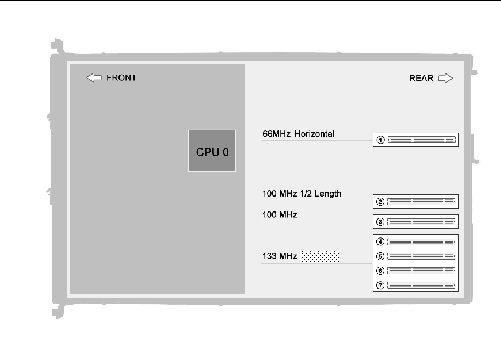
Follow these steps to install a vertical mount PCI card in one of the server’s six vertical slots (see FIGURE 4-4 for location). Four of the six vertical slots have a mechanical retention latch (MRL); two of the slots have a retaining bracket.
1. Power off the server, including any attached peripherals, and disconnect the server from the electrical outlet. If your server includes two power supplies, ensure that both power cords are disconnected from the electrical outlet.
Refer to Section 4.2, Powering Off the Server and Removing the Cover.
2. Remove the top cover from the server.
3. Remove the card you are replacing using one of the following two methods, depending on which slot you are installing to:
FIGURE 4-5 Removing or Installing a Vertical PCI Card in a Vertical Slot With an MRL
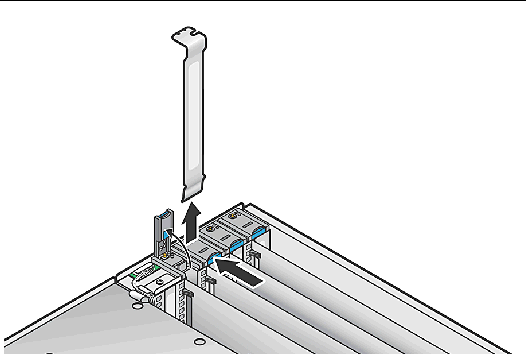
FIGURE 4-6 Removing or Installing a Vertical PCI Card in a Vertical Slot Without an MRL

4. Remove the card you are replacing. If the slot is blank, remove its metal slot cover from the back panel.
You can also remove the plastic air-baffle insert from the PCI slot, but if there are cards in adjacent slots, it is a best practice keep the plastic air-baffle inserts in the PCI slots. This will prevent the adjacent cards from touching each other.
5. Insert the new card into the slot. Push down evenly on both corners of the card to ensure it is seated correctly.
6. Secure the PCI card using one of the following two methods:
7. Before reinstalling the cover on the server, check the routing of all cables for obstructions.
Follow these steps to install a horizontal mount PCI card (see FIGURE 4-4 for the location). The server has one horizontal slot located under the power-supply cage assembly that supports one half-length, 66-MHz PCI card.
1. Power off the server, including any attached peripherals, and disconnect the server from the electrical outlet. If your server includes two power supplies, ensure that both power cords are disconnected from the electrical outlet.
Refer to Section 4.2, Powering Off the Server and Removing the Cover.
2. Remove the top cover from the server.
3. Remove the power-supply cage assembly.
Refer to Section 4.5.9.2, Replacing a Power-Supply Cage Assembly.
4. On the outside of the server back panel, loosen the screw holding the card latch (see FIGURE 4-7).
5. Raise the card latch as far as possible and then pivot it toward the rear of the chassis.
FIGURE 4-7 Removing a Horizontal PCI Card
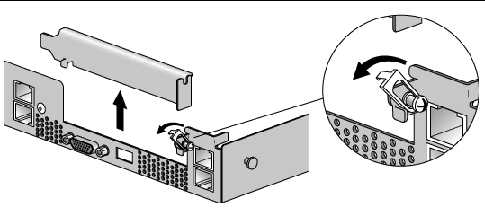
6. Remove any existing PCI card from the PCI riser. If the slot is blank, remove its metal slot cover from the server back panel.
7. Remove the PCI riser from the PCI card connector on the motherboard. Press on the connector-release levers to release the riser.
8. Install the new PCI card into the riser assembly (see FIGURE 4-8).
9. Reinstall the riser with the card into the connector on the motherboard. Push down evenly on both corners of the riser until the release levers close.
10. Pivot the back-panel card latch up and then slide it down until it captures the PCI card bracket. Tighten the screw to secure the latch.
FIGURE 4-8 Installing the Horizontal PCI Card and Riser
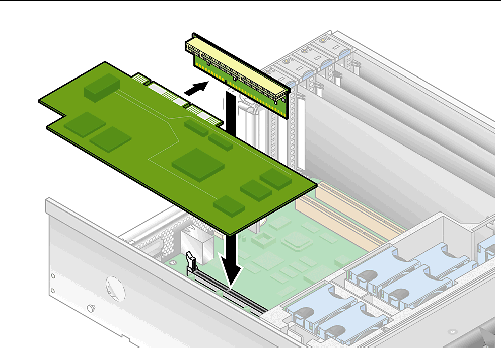
11. If you are installing an LSI MegaRAID card:
Otherwise, skip to Step 12.
12. Reinstall the power-supply cage assembly.
Refer to Section 4.5.9.2, Replacing a Power-Supply Cage Assembly.
13. Before reinstalling the cover on the server, check the routing of all cables for obstructions.
| Note - You must install this card into the horizontal PCI slot located under the power-supply cage. |
When installing the LSI MegaRAID card with battery backup into the original release (chassis PN 380-1010) of the Sun Fire V40z server, you must plug the extender cable (included with the card) into the system’s SCSI signal cable.
1. If you have not already done so, perform the actions in Section 4.5.1.5, Installing a Horizontal PCI Card and Riser, up to Step 11.
2. Disconnect the server’s SCSI signal cable from the motherboard.
FIGURE 4-9 shows the location of the SCSI signal cable motherboard connector on the original release (chassis PN 380-1010) of the Sun Fire V40z server.
In this view, the rear fan-cage assembly and the power-supply cage have been removed. The SCSI connector is located under the power-supply cage; the SCSI signal cable is routed underneath the motherboard.

FIGURE 4-9 SCSI Signal Cable and Connector (Original Release of the Sun Fire V40z Server)
3. Plug the end of the extender cable that is labeled “SCSI Cable” into the SCSI signal cable that you disconnected from the motherboard.
4. Plug the other end of the extender cable, which is labeled, “SCSI CNTRLR Board,” into the LSI MegaRAID card connector.
Lay the extender cable over any existing cards.
5. Reinstall the power-supply cage assembly.
Refer to Section 4.5.9.2, Replacing a Power-Supply Cage Assembly.
6. Before reinstalling the cover on the server, check the routing of all cables for obstructions.
| Note - You must install this card into the horizontal PCI slot located under the power-supply cage. |
When installing the LSI MegaRAID card with battery backup into the updated release (chassis PN 380-1206) of the Sun Fire V40z server, you replace the SCSI signal cable in the system with the new SCSI signal cable that is included with the card.
1. If you have not already done so, perform the actions in Section 4.5.1.5, Installing a Horizontal PCI Card and Riser, up to Step 11.
2. Remove the rear fan-cage assembly.
Refer to Section 4.5.8.4, Replacing the Rear Fan-Cage Assembly.
3. Disconnect the server’s SCSI signal cable from SCSI connector A on the motherboard and from the SCSI backplane (see FIGURE 4-10).
FIGURE 4-10 shows the location of SCSI connector A on the updated release (chassis PN 380-1206) of the server; in this view, the rear fan-cage assembly and the power-supply cage have been removed. In this updated chassis, the SCSI signal cable is routed along the sidewall of the chassis and does not pass underneath the motherboard.
4. Remove the SCSI signal cable from the chassis.
5. Insert the new SCSI signal cable into the chassis and route it loosely along the routing path shown in FIGURE 4-10.
6. Plug the end of the new SCSI signal cable, labeled “SCSI BKPLN,” into the SCSI backplane connector (see FIGURE 4-10 for the connector location).
7. Route the new SCSI signal cable along the chassis wall, behind CPU 0 DDR VRM (see FIGURE 4-10).
8. Continue routing the new SCSI signal cable between SCSI connector A and the power-supply cage connector (see FIGURE 4-10).
9. Continue routing the new SCSI signal cable parallel with the horizontal PCI slot, then fold it over the top of the LSI MegaRAID card that is installed in the riser (see FIGURE 4-10).
10. Plug the end of the new SCSI signal cable, labeled “SCSI CNTRLR BOARD,” into the LSI MegaRAID card rear SCSI connector (channel 0) (see FIGURE 4-10).
11. Reinstall the power-supply cage assembly.
Refer to Section 4.5.9.2, Replacing a Power-Supply Cage Assembly.
Ensure that the new cable does not obstruct the power-supply cage connector on the motherboard before locking the cage in place.
12. Manually fold over the top of the new SCSI signal cable where it runs next to the power-supply cage to provide clearance for reinstalling the rear fan-cage assembly.
13. Reinstall the rear fan-cage assembly.
Refer to Section 4.5.8.4, Replacing the Rear Fan-Cage Assembly.
Ensure that the fan cage does not bind the SCSI signal cable when you install the cage.
14. Before reinstalling the cover on the server, check the routing of all cables for obstructions.
FIGURE 4-10 SCSI Signal Cable and Connectors (Updated Release of the Sun Fire V40z Server)
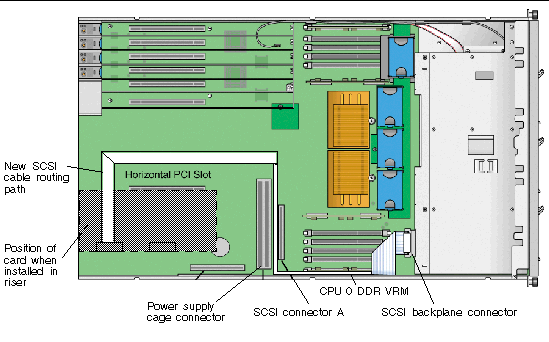
The following procedure describes how to remove and replace a SCSI hard disk drive (HDD) and carrier.
| Note - SCSI HDDs are hot-pluggable in integrated-mirroring (IM) configurations. Refer to Section D.1.2, Integrated Mirroring for more information.
Also refer to Section 4.3.1, SCSI ID Assignments. |
1. Power off the server, including any attached peripherals, and disconnect the server from the electrical outlet. If your server includes two power supplies, ensure that both power cords are disconnected from the electrical outlet.
Refer to Section 4.2, Powering Off the Server and Removing the Cover.
You do not need to remove the top cover for this procedure.
2. Squeeze the release latch and carefully swing the arm to the left as far as it will go (see FIGURE 4-11).
FIGURE 4-11 Opening the Release Latch on the SCSI Hard Disk Drive Carrier

3. Grasp the carrier bezel with both hands and carefully pull the carrier out of the drive bay.
| Note - Avoid using the arm to remove the carrier. |
4. Grasping the body of the drive in both hands, carefully guide the connector end of the HDD into the drive bay, sliding the carrier into the bay until the arm engages and partially closes itself.
5. Push the arm forward and latch it to lock the carrier in place.
The following procedure describes how to remove and replace the DVD-ROM/diskette drive assembly.
1. Power off the server, including any attached peripherals, and disconnect the server from the electrical outlet. If your server includes two power supplies, ensure that both power cords are disconnected from the electrical outlet.
Refer to Section 4.2, Powering Off the Server and Removing the Cover.
2. Remove the top cover from the server.
3. Remove the cable service loop from the clip on the right wall of the server chassis, including the round, black USB cable.
4. On the front panel of the server, press in the latch on the left side of the DVD-ROM/diskette drive assembly and remove the assembly from the server (see FIGURE 4-12).
Feed the cable through the openings in the chassis as you remove the assembly.
5. Disconnect the ribbon cable connector from the rear of the assembly.
FIGURE 4-12 Removing the DVD-ROM/Diskette Drive Assembly
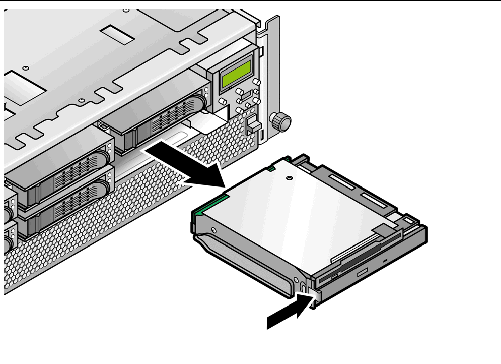
6. To install the new assembly, connect the ribbon cable connector to the rear of the assembly.
7. Align the assembly with the bay opening and press in firmly on both corners of the assembly until the latch clicks into place.
As you insert the assembly, pull the excess cable back in through the openings in the chassis.
8. Replace the cable service loop in the clip on the right wall of the server chassis.
9. Before reinstalling the cover on the server, check the routing of all cables for obstructions.
The CPU card is an optional daughterboard that slides into the front of the server. You must remove the front bezel before you can replace the CPU card.
1. Power off the server, including any attached peripherals, and disconnect the server from the electrical outlet. If your server includes two power supplies, ensure that both power cords are disconnected from the electrical outlet.
Refer to Section 4.2, Powering Off the Server and Removing the Cover.
You do not need to remove the cover for this procedure.
2. Press the buttons on both sides of the front bezel to release the spring clips, then swing the bezel top downward (see FIGURE 4-13).
3. Lift the bezel off of the lower mounting slots, so that the hooks are clear of the chassis, and set the bezel aside.
FIGURE 4-13 Removing the Front Bezel
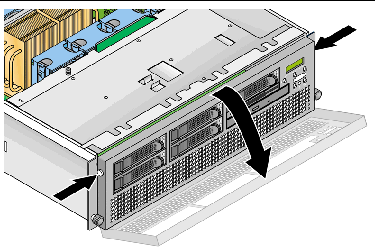
4. Open the CPU card door by pressing down on the two buttons on both sides of the door (see FIGURE 4-14).
The CPU card door, located under the hard drive bays, provides access to the CPU card.
FIGURE 4-14 Opening the CPU Card Door
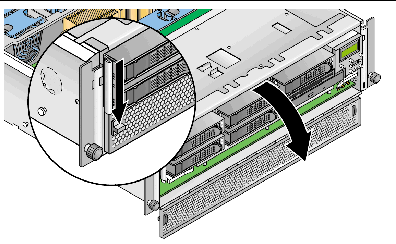
5. If you are installing the CPU card as a new option, skip to Section 4.5.4.2, Installing the CPU Card and Front Bezel.
If you are replacing an existing card, continue with the next step.
6. Simultaneously rotate the two levers on each side of the CPU card to release it from the backplane, then carefully pull the CPU card out of the server (see FIGURE 4-15).
FIGURE 4-15 Removing the CPU Card From the Chassis

7. Set the CPU card on an ESD-resistant surface.
8. Remove any replaceable components (CPUs, memory modules, VRMs) from the old CPU card and set them aside on an ESD-resistant surface.
Refer to the following procedures:
9. Install components to the new CPU card (either as new components or as components you are transferring from an old CPU card).
Refer to the following procedures:
After you install any new components to the CPU card, install it into the server and replace the front bezel as described in this procedure.
1. Align the rear corners of the CPU card with the plastic alignment guides inside the server chassis, then slide the CPU card into the chassis (see FIGURE 4-16).
2. Press in firmly and evenly on both corners of the CPU card until the levers on the CPU card engage with the channels on each side.
FIGURE 4-16 Installing the CPU Card Into the Chassis

3. Simultaneously rotate the two levers into the CPU card to plug the card into the system.
The levers snap into place when the CPU card is completely installed.
4. Close the CPU card door by pressing down on the latches and releasing them when the door is in position.
5. Replace the bezel by aligning the bezel hooks with the lower mounting holes.
6. Move the top of the bezel toward the chassis and ensure that it clears the SCSI drives and the operator panel buttons.
7. Press the bezel until the upper spring clips lock into place.
The following procedure describes how to remove and replace the operator panel and liquid crystal display (LCD) assembly.
1. Power off the server, including any attached peripherals, and disconnect the server from the electrical outlet. If your server includes two power supplies, ensure that both power cords are disconnected from the electrical outlet.
Refer to Section 4.2, Powering Off the Server and Removing the Cover.
2. Remove the top cover from the server.
3. Remove the two non-captive screws and loosen the single captive screw that secures the assembly to the chassis (see FIGURE 4-17).
FIGURE 4-17 Removing the Operator Panel and LCD Assembly

4. Pull the assembly out from the chassis front about 1 inch (25.4 mm), until you can reach the two cables attached to the rear of the assembly.
5. Disconnect the two cables from the circuit board connectors on the rear of the assembly.
6. Remove the assembly from the chassis.
7. To install the new assembly, reverse Step 3 through Step 6.
8. Before reinstalling the cover on the server, check the routing of all cables for obstructions.
The following procedure describes how to remove and replace the SCSI backplane assembly.
1. Power off the server, including any attached peripherals, and disconnect the server from the electrical outlet. If your server includes two power supplies, ensure that both power cords are disconnected from the electrical outlet.
Refer to Section 4.2, Powering Off the Server and Removing the Cover.
2. Remove the top cover from the server.
3. Remove all HDD carriers and the DVD-ROM/diskette drive assembly from the bays on the server front.
All drives and carriers must be disconnected from the SCSI backplane before you can remove it.
Refer to Section 4.5.2, SCSI Hard Disk Drive and Carrier and Section 4.5.3, DVD-ROM/Diskette Drive Assembly.
4. Remove the center air baffle (see FIGURE 4-18).
Lift the rear edge of the baffle, then slide it toward the rear of the server to disengage the hooks on the front edge of the baffle.
5. Disconnect the SCSI signal cable and the power cable that connect to the rear side of the SCSI backplane circuit board (see FIGURE 4-19).
FIGURE 4-18 Removing the Center Air Baffle

6. Loosen the two captive screws that secure the SCSI backplane assembly to the chassis (see FIGURE 4-19).
7. Lift the SCSI backplane assembly up and out of the chassis.
FIGURE 4-19 Removing the SCSI Backplane Assembly
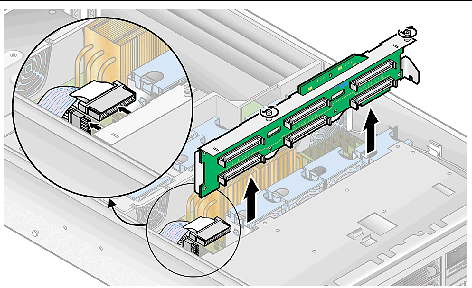
8. To install the new SCSI backplane assembly, reverse Step 3 through Step 7.
9. Before reinstalling the cover on the server, check the routing of all cables for obstructions.
The 12 replaceable cooling fans in the Sun Fire V40z server plug into two different fan-cage assemblies. Use the correct procedure in this section:
The cooling fans in a Sun Fire V40z server are numbered as shown in FIGURE 4-20.

FIGURE 4-20 Fan Numbering in a Sun Fire V40z Server, Top View
1. Power off the server, including any attached peripherals, and disconnect the server from the electrical outlet. If your server includes two power supplies, ensure that both power cords are disconnected from the electrical outlet.
Refer to Section 4.2, Powering Off the Server and Removing the Cover.
2. Remove the top cover from the server.
3. Remove the center air baffle (see FIGURE 4-18).
Lift the rear edge of the baffle, then move it toward the rear of the server to disengage the hooks on the front edge of the baffle.
4. Identify the fan(s) to be replaced in either the front or rear fan cage.
5. Squeeze the retainer clip on the edge of the fan, then pull the fan straight up to disengage its connector and remove it from its fan cage (see FIGURE 4-21).
FIGURE 4-21 Removing an Individual Cooling Fan, Cage Shown Removed From Server
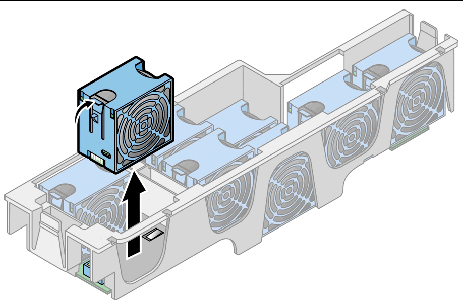
6. To install a new fan, align it with the bay in the fan cage and push down firmly and evenly on both top corners of the fan to engage it with the cage connector.
7. Before reinstalling the cover on the server, check the routing of all cables for obstructions.
The front fan-cage assembly holds fans 9 through 12 (numbering is indicated on the top of the center air baffle).
1. Power off the server, including any attached peripherals, and disconnect the server from the electrical outlet. If your server includes two power supplies, ensure that both power cords are disconnected from the electrical outlet.
Refer to Section 4.2, Powering Off the Server and Removing the Cover.
2. Remove the top cover from the server.
3. Remove the center air baffle (see FIGURE 4-18).
Lift the rear edge of the baffle, then slide it toward the rear of the server to disengage the hooks on the front edge of the baffle.
4. Remove the plastic air baffle from the base of fan 12 (see EQUATION 4-8).
5. Remove the three screws that secure the fan-cage assembly to the motherboard (see EQUATION 4-8).
6. Lift the assembly up and out of the server.
7. Remove all individual fans from the fan cage.
Squeeze the retainer clip on the edge of the fan, then pull the fan straight up to disengage its connector and remove it from the fan cage (see FIGURE 4-21).
8. To install the new fan-cage assembly, reverse Step 3 through Step 7.
9. Power on the server before you replace the cover so that you can verify that all fans are spinning and that a green LED is illuminated on each fan.
If the fans are not spinning, it is very important that you power off the server and reseat the fan cage so that the motherboard connector is fully engaged.
10. Before reinstalling the cover on the server, check the routing of all cables for obstructions.
EQUATION 4-8 Removing the Front Fan-Cage Assembly

The rear fan-cage assembly holds fans 1 through 8 (numbering is indicated on the top of the rear fan cage).
1. Power off the server, including any attached peripherals, and disconnect the server from the electrical outlet. If your server includes two power supplies, ensure that both power cords are disconnected from the electrical outlet.
Refer to Section 4.2, Powering Off the Server and Removing the Cover.
2. Remove the center air baffle (see FIGURE 4-18).
Lift the rear edge of the baffle, then move it toward the rear of the server to disengage the hooks on the front edge of the baffle.
3. Squeeze the retainer clips on each end of the fan cage inward (see FIGURE 4-22).
4. Pull straight up on the fan-cage assembly to disengage it from the motherboard connector.
FIGURE 4-22 Removing the Rear Fan-Cage Assembly
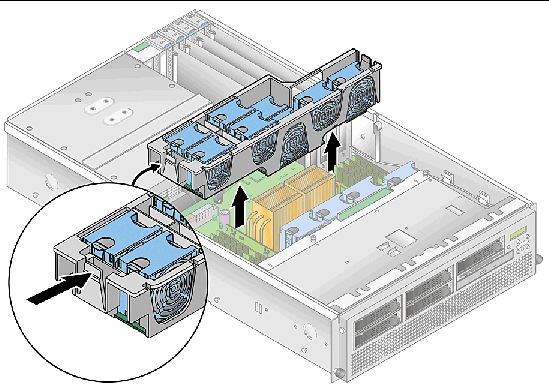
5. Lift the assembly up and out of the server.
6. Remove all individual fans from the fan cage.
Squeeze the retainer clip on the edge of a fan, then pull the fan straight up to disengage its connector and remove it from the fan cage (see FIGURE 4-21).
7. To install the new fan-cage assembly, first install all individual fans into the new fan cage.
Refer to Section 4.5.7.2, Replacing an Individual Cooling Fan.
8. Align the fan cage with the chassis and push down on both ends of the fan cage until both retaining clips click securely into place and the fan-cage connector fully engages with the motherboard connector.
9. Power on the server before you replace the cover so that you can verify that all fans are spinning and that a green LED is illuminated on each fan.
If the fans are not spinning, it is very important that you power off the server and reseat the fan cage so that the motherboard connector is fully engaged.
10. Before reinstalling the cover on the server, check the routing of all cables for obstructions.
The Sun Fire V40z server can hold one or two power supplies in its power-supply cage. Use the correct procedure in this section:
| Note - The individual power supplies on the Sun Fire V40z server are hot-swappable. You do not need to power off the server before removing and replacing a power supply. |
1. At the outside rear of the server, pull the finger ring on the power-supply handle toward you to disengage the power-supply connector from the power-distribution backplane (see FIGURE 4-23).
| Note - A twisted, plastic tie-wrap through the finger ring holds the power-supply handle in place. Untwist this tie-wrap to pull the handle out. |
FIGURE 4-23 Removing an Individual Power Supply

2. Slide the power supply out of the power-supply cage and chassis.
3. To install the new power supply:
a. Open the power-supply handle to the fully open position, as shown in FIGURE 4-23.
b. Insert the power supply into the power-supply cage and push it inward until it stops at the backplane.
c. Push the power-supply handle closed until it locks into place.
The Sun Fire V40z server contains a power-supply cage assembly that can hold up to two power supplies. The assembly includes a power-distribution backplane and an air baffle.
1. Power off the server, including any attached peripherals, and disconnect the server from the electrical outlet. If your server includes two power supplies, ensure that both power cords are disconnected from the electrical outlet.
Refer to Section 4.2, Powering Off the Server and Removing the Cover.
2. Remove the top cover from the server.
3. Remove all power supplies from the power-supply cage.
Refer to Section 4.5.9.1, Replacing an Individual Power Supply.
4. Remove the power-supply cage assembly:
a. Pull the metal handle on the top of the cage toward the front of the server so that the hinged cams lift the cage and disconnect it from the motherboard (see FIGURE 4-24).
b. Lift the front of the cage and disengage its metal tabs from their mounting holes on the server back panel to remove it from the chassis.
FIGURE 4-24 Removing the Power-Supply Cage Assembly
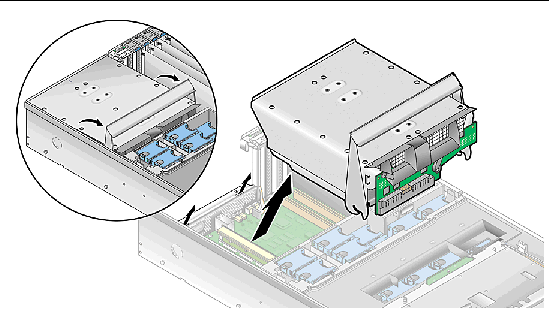
5. To install the new power-supply cage assembly:
a. Insert the assembly into the chassis with the rear of the assembly angled downward and the assembly handle in the fully open position.
b. Carefully insert the metal tabs on the rear of the assembly into their slots on the chassis back panel.
c. With the tabs in place, set the front of the assembly down on the motherboard connector.
d. Press the metal handle on the top of the assembly down until the connectors on the motherboard engage with the assembly backplane.
6. Reinstall the power supplies into the new power-supply cage assembly.
Refer to Section 4.5.9.1, Replacing an Individual Power Supply.
7. Before reinstalling the cover on the server, check the routing of all cables for obstructions.
The Sun Fire V40z server contains memory voltage-regulator modules (VRMs) in four locations. Two memory VRMs are on the motherboard and two are on the optional CPU card. Use the correct procedure in this section:
1. Power off the server, including any attached peripherals, and disconnect the server from the electrical outlet. If your server includes two power supplies, ensure that both power cords are disconnected from the electrical outlet.
Refer to Section 4.2, Powering Off the Server and Removing the Cover.
2. Remove the top cover from the server.
3. Remove the center air baffle (see FIGURE 4-18).
Lift the rear edge of the baffle, then move it toward the rear of the server to disengage the hooks on the front edge of the baffle.
4. Remove the rear fan-cage assembly:
a. Squeeze the retainer clips on each end of the fan cage inward (see FIGURE 4-22).
Refer to Section 4.5.8.4, Replacing the Rear Fan-Cage Assembly.
b. Pull straight up on the fan-cage assembly to disengage it from the motherboard connector.
c. Lift the assembly up and out of the server.
5. Identify the memory VRM that must be replaced.
The memory VRM is in the outer slot, furthest from the CPU.
6. Remove the memory VRM by pressing down on the ejector bars at both ends of the socket and lifting the VRM straight out of the chassis (see FIGURE 4-25).
FIGURE 4-25 Removing a Memory VRM
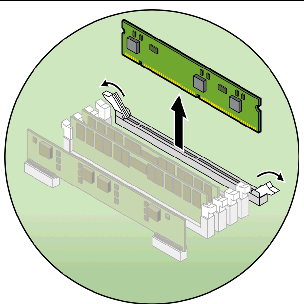
7. To install the new VRM to the socket, press down firmly and evenly on both top corners of the VRM until the ejector levers close over the notches.
8. Reinstall the rear fan-cage assembly.
Refer to Section 4.5.8.4, Replacing the Rear Fan-Cage Assembly.
9. Replace the center air baffle.
Refer to Section 4.5.6, SCSI Backplane Assembly.
10. Before reinstalling the cover on the server, check the routing of all cables for obstructions.
1. Power off the server, including any attached peripherals, and disconnect the server from the electrical outlet. If your server includes two power supplies, ensure that both power cords are disconnected from the electrical outlet.
Refer to Section 4.2, Powering Off the Server and Removing the Cover.
You do not need to remove the cover for this procedure.
2. Remove the front bezel from the server by pressing in on the rubberized buttons on each side of the bezel, then swinging the bezel top downward (see FIGURE 4-13).
Refer to Section 4.5.4.1, Removing the Front Bezel and CPU Card.
3. Open the CPU card door, which is located under the hard drive bays, to access the CPU card. Press in the two buttons on the door and swing it downward so that it is open 180 degrees from the closed position (see FIGURE 4-14).
4. Open the two plastic levers on the CPU card corners simultaneously to release it from its backplane, then carefully pull it out of the server (see FIGURE 4-15).
5. Set the CPU card on an ESD-resistant surface.
6. Identify the memory VRM that must be replaced.
The memory VRM is in the outer slot, furthest from the CPU.
7. Remove a memory VRM by pressing down on the ejector bars at both ends of the socket and lifting the VRM straight out of the chassis (see FIGURE 4-25).
8. Install the new VRM to the socket by pressing down firmly and evenly on both top corners of the VRM until the ejector levers close over the notches.
9. Replace the CPU card into the server (see FIGURE 4-16):
a. Carefully align the rear corners of the CPU card with the plastic alignment tracks inside the server chassis, then slide the CPU card into the tracks.
b. Press in firmly and evenly on both corners of the CPU card until it engages the backplane.
c. Lock down the two plastic latches on the corners of the CPU card to secure it in place.
11. Replace the front bezel onto the server.
The Sun Fire V40z server contains CPU voltage-regulator modules (VRMs) in four locations. Two CPU VRMs are on the motherboard and two are on the optional CPU card. Use the correct procedure in this section:
This procedure covers both the original release of the Sun Fire V40z server (chassis part number [PN] 380-1010) and the updated release (chassis PN 380-1206).
1. Power off the server, including any attached peripherals, and disconnect the server from the electrical outlet. If your server includes two power supplies, ensure that both power cords are disconnected from the electrical outlet.
Refer to Section 4.2, Powering Off the Server and Removing the Cover.
2. Remove the top cover from the server.
3. Remove the center air baffle (see FIGURE 4-18).
Lift the rear edge of the baffle, then move it toward the rear of the server to disengage the hooks on the front edge of the baffle.
4. Remove the rear fan-cage assembly:
a. Squeeze the retainer clips on each end of the fan cage inward (see FIGURE 4-22).
Refer to Section 4.5.8.4, Replacing the Rear Fan-Cage Assembly.
b. Pull straight up on the fan-cage assembly to disengage it from the motherboard connector.
c. Lift the assembly up and out of the server.
5. Identify the CPU VRM that must be replaced.
The CPU VRM is in the inner slot, closest to the CPU.
| Note - For the VRM for CPU 1 (from the front of the server, CPU 1 is on the right side), first remove the plastic air baffle from fan 12. |
6. (Updated release of Sun Fire V40z server only) Remove the wire clip that secures the CPU VRM in place. With your index fingers, gently lift up on either side of the horizontal section of the wire clip and pull it back over the top of the VRM (see FIGURE 4-26).
FIGURE 4-26 Removing the Wire Clip From the CPU VRM
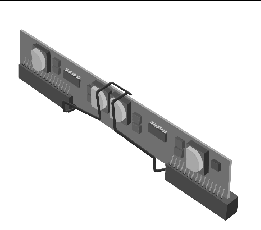
7. Remove the CPU VRM by pulling it straight up, out of its socket (see FIGURE 4-27).
FIGURE 4-27 Removing a CPU VRM
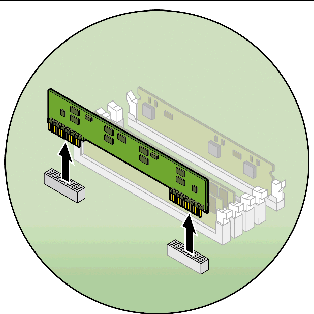

|
Caution - When installing a VRM, ensure that pin “A1,” on the VRM, is aligned with the “A1” reference designation on the motherboard. |
8. Press the new CPU VRM into the empty socket, ensuring that the notch in the CPU VRM aligns with the key in the connector.
9. (Updated release of Sun Fire V40z server only) Reposition the wire clip to secure the CPU VRM in place. With your index fingers, gently lift up on either side of the horizontal section of the wire clip, and reposition it over the top of the VRM (see FIGURE 4-26).
10. If you removed the plastic air baffle from fan 12 (see Step 5), replace the air baffle now.
11. Reinstall the rear fan-cage assembly.
Refer to Section 4.5.8.4, Replacing the Rear Fan-Cage Assembly.
12. Replace the center air baffle.
Refer to Section 4.5.6, SCSI Backplane Assembly.
13. Before reinstalling the cover on the server, check the routing of all cables for obstructions.
1. Power off the server, including any attached peripherals, and disconnect the server from the electrical outlet. If your server includes two power supplies, ensure that both power cords are disconnected from the electrical outlet.
Refer to Section 4.2, Powering Off the Server and Removing the Cover.
You do not need to remove the cover for this procedure.
2. Remove the front bezel from the server by pressing in on the rubberized buttons on each side of the bezel, then swinging the bezel top downward (see FIGURE 4-13).
3. Open the CPU card door, which is located under the hard drive bays, to access the CPU card. Press in the two buttons on the door and swing it downward so that it is open 180 degrees from the closed position (see FIGURE 4-14).
4. Open the two plastic levers on the CPU card corners simultaneously to release the card from its backplane, then carefully pull it out of the server (see FIGURE 4-15).
5. Set the CPU card on an ESD-resistant surface.
6. Identify the CPU VRM that must be replaced.
The CPU VRM is in the inner slot, closest to the CPU.
7. (Updated release of Sun Fire V40z server only) Remove the wire clip that secures the CPU VRM in place. With your index fingers, gently lift up on either side of the horizontal section of the wire clip (arrow 1), and pull it back over the top of the VRM (see FIGURE 4-26).
8. Remove the CPU VRM by pulling it straight up, out of its socket (see FIGURE 4-27).

|
Caution - When installing a VRM, ensure that pin “A1,” on the VRM, is aligned with the “A1” reference designation on the motherboard. |
9. To install the new CPU VRM, press it into the empty socket until it snaps into place, ensuring that the notch in the CPU VRM aligns with the key in the connector.
10. (Updated release of Sun Fire V40z server only) Reposition the wire clip to secure the CPU VRM in place. With your index fingers, gently lift up on either side of the horizontal section of the wire clip, and reposition it over the top of the VRM (see FIGURE 4-26).
11. Replace the CPU card into the server (see FIGURE 4-16):
a. Carefully align the rear corners of the CPU card with the plastic alignment tracks inside the server chassis, then slide the CPU card into the tracks.
b. Press in firmly and evenly on both corners of the CPU card until it engages the backplane.
c. Lock down the two plastic latches on the corners of the CPU card to secure it in place.
13. Replace the front bezel onto the server.
The Sun Fire V40z server contains memory modules in four memory-bank locations. Two banks are on the motherboard and two banks are on the optional CPU card. Use the correct procedure in this section:
Use the following information and rules when you use the procedures in this section to replace or add dual inline memory modules (DIMMs) to the server:
The following table shows the supported DIMM sizes, speeds and CAS latencies:
The following table shows the number of supported DIMMs for each possible CPU configuration:
| Note - If you mix two different speeds of DIMMs, the memory clocks down to the lower speed. The server does not support this configuration. |
1. Power off the server, including any attached peripherals, and disconnect the server from the electrical outlet. If your server includes two power supplies, ensure that both power cords are disconnected from the electrical outlet.
Refer to Section 4.2, Powering Off the Server and Removing the Cover.
2. Remove the top cover from the server.
3. Remove the center air baffle (see FIGURE 4-18).
Lift the rear edge of the baffle, then move it toward the rear of the server to disengage the hooks on the front edge of the baffle.
4. Remove the rear fan-cage assembly:
a. Squeeze the retainer clips on each end of the fan cage inward (see FIGURE 4-22).
Refer to Section 4.5.8.4, Replacing the Rear Fan-Cage Assembly.
b. Pull straight up on the fan-cage assembly to disengage it from the motherboard connector.
c. Lift the assembly up and out of the server.
5. Locate the memory-module connector in which you will install or replace a memory module.
| Note - For the memory modules next to CPU 1 (from the front of the server, CPU 1 is on the right side), first remove fan 12 and the plastic air baffle to obtain easier access to the ejector levers. |
6. Remove a memory module by pressing down on the ejector levers at both ends of the memory module’s socket (see FIGURE 4-28).
7. Ensure that the memory-module socket’s ejector levers are open (rotated outward) to allow the new module to be inserted.
8. Align the memory module’s edge connector with the alignment key and insert the memory module into the connector.
| Note - Refer to Section 4.5.12.1, Memory Module Population Rules for important information about DIMM requirements. |
9. If you removed fan 12 and the plastic air baffle (see Step 5), replace the fan and plastic air baffle now.
10. Reinstall the rear fan-cage assembly.
Refer to Section 4.5.8.4, Replacing the Rear Fan-Cage Assembly.
11. Replace the center air baffle.
Refer to Section 4.5.6, SCSI Backplane Assembly.
12. Before reinstalling the cover on the server, check the routing of all cables for obstructions.
FIGURE 4-28 Removing a Memory Module
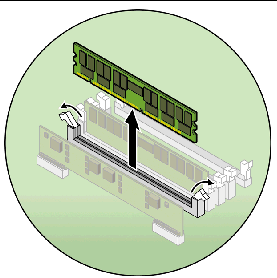
1. Power off the server, including any attached peripherals, and disconnect the server from the electrical outlet. If your server includes two power supplies, ensure that both power cords are disconnected from the electrical outlet.
Refer to Section 4.2, Powering Off the Server and Removing the Cover.
You do not need to remove the cover for this procedure.
2. Remove the front bezel from the server by pressing in on the rubberized buttons on each side of the bezel, then swinging the bezel top downward (see FIGURE 4-13).
3. Open the CPU card door, which is located under the hard drive bays, to access the CPU card. Press in the two buttons on the door and swing it downward so that it is open 180 degrees from the closed position (see FIGURE 4-14).
4. Open the two plastic levers on the CPU card corners simultaneously to release the card from its backplane, then carefully pull the card out of the server (see FIGURE 4-15).
5. Set the CPU card on an ESD-resistant surface.
6. Locate the memory-module connector in which you will install or replace a memory module.
7. Remove a memory module by pressing down on the ejector levers at both ends of the memory module’s socket (see FIGURE 4-28).
8. Ensure that the memory-module socket’s ejector levers are open (rotated outward) to allow the new module to be inserted.
9. Align the memory module’s edge connector with the alignment key and insert the memory module into the connector.
| Note - Refer to Section 4.5.12.1, Memory Module Population Rules for important information about DIMM requirements. |
10. Replace the CPU card into the server (see FIGURE 4-16):
a. Carefully align the rear corners of the CPU card with the plastic alignment tracks inside the server chassis, then slide the CPU card into the tracks.
b. Press in firmly and evenly on both corners of the CPU card until it engages the backplane.
c. Lock down the two plastic latches on the corners of the CPU card to secure it in place.
12. Replace the front bezel onto the server.

|
Caution - In a two or four CPU configuration of the Sun Fire V40z server, all CPUs must be the same stepping version and the same speed. Before adding or replacing a CPU, ensure that you have read the information in Section 4.4.2, No Mixing of CPU Stepping Versions. |
The Sun Fire V40z server supports two or four CPU configurations. In a two CPU configuration, you must use the two motherboard positions (CPU 0 and CPU 1). Four CPUs are supported with two on the motherboard and two on the CPU card (CPU 2 and CPU 3). Use the correct procedure in this section:
There are two types of heat sink spring assemblies and accompanying standoffs:
They are not distinguishable until they are removed.

|
Caution - The two spring assemblies and the accompanying standoffs must be the same type in order to equalize the spring force on both sides of the heat sink. |
1. Power off the server, including any attached peripherals, and disconnect the server from the electrical outlet. If your server includes two power supplies, ensure that both power cords are disconnected from the electrical outlet.
Refer to Section 4.2, Powering Off the Server and Removing the Cover.
2. Remove the top cover from the server.
3. Remove the center air baffle (see FIGURE 4-18).
Lift the rear edge of the baffle, then move it toward the rear of the server to disengage the hooks on the front edge of the baffle.
4. Remove fans 9 through 11 from the front fan-cage assembly to provide clearance.
Squeeze the retainer clip on the edge of the fan, then pull the fan straight up to disengage its connector and remove it from its fan cage (see FIGURE 4-21).
| Note - For fans 9 through 12, the numbers are imprinted on the plastic of the center air baffle. |
5. Remove the rear fan-cage assembly to provide clearance.
Squeeze the retainer clips on each end of the fan cage inward, then pull straight up on the fan-cage assembly to disengage it from the motherboard connector (see FIGURE 4-22).
6. Loosen the captive screw that secures the heat sink hold-down assembly crossbar, then remove the crossbar from within the heat sink fins (see FIGURE 4-29).
FIGURE 4-29 Removing the Heat Sink and CPU
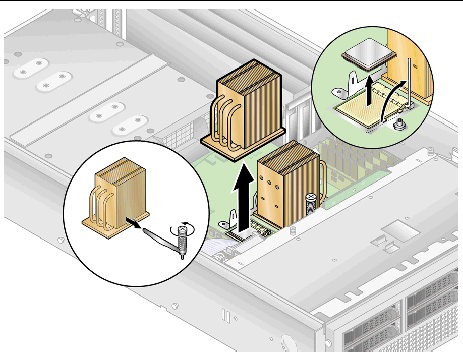

|
Caution - The heat sink can become extremely hot. Ensure it has had sufficient time to cool before handling. |
7. Twist the heat sink slightly to the right or left to break the seal with the thermal grease, then lift the heat sink away from the CPU.
8. Use an alcohol pad to remove all thermal grease from the bottom of the heat sink.
Be careful not to get any thermal grease on your fingers. It is very sticky and you might contaminate other components when handling them.
9. Place the heat sink upsidedown on a flat surface to prevent the thermal grease from contaminating other components.
10. Pull the socket release lever up to the fully open, perpendicular position (see FIGURE 4-29).
11. Lift the CPU out of the socket, leaving the release lever in the open position.

|
Caution - Ensure that any thermal grease that might remain from the heat sink does not come into contact with the CPU socket or pins. |

|
Caution - Observe the appropriate ESD precautions. |
2. Ensure that the CPU socket release lever is in the fully open, perpendicular position (see FIGURE 4-30).
3. Align the small triangle on the corner of the CPU with the triangle on the corner of the socket.
FIGURE 4-30 Installing a CPU into Its Socket

4. Insert the CPU into the socket.
5. When the CPU is fully seated in the socket, rotate the socket release lever down until it snaps into place, securing the CPU in the socket (see FIGURE 4-30).
6. Use the syringe to apply approximately 0.2 ML/CC of thermal grease in a circular pattern to the top of the CPU. (Each drop of thermal grease consists of approximately 0.05 ML/CC.)
7. Gently distribute the thermal grease and remove any excess so that only an extremely thin, uniform layer remains. If any voids or crevices appear that could lead to air pockets, reapply the grease until you achieve a thin but compact consistency.
8. Inspect the heat sink for dust and lint. Clean again if necessary.
9. Carefully position the heat sink on the CPU, aligning it with the mounting posts to reduce movement after it makes initial contact with the layer of thermal grease.
The cooling pipes on the heat sink should be facing toward the outside of the machine.

|
Caution - If the heat sink is moved too much during its installation, the layer of thermal grease might become uneven, leading to component damage. |
10. After the heat sink is correctly aligned, reinsert the hold-down assembly crossbar through the heat sink fins (see FIGURE 4-31):
a. Insert the crossbar from the front side of the heat sink and align it with the alignment mark on the base of the heat sink.
b. Push the crossbar through the heat sink fins and insert the crossbar end into the tab on the hold-down assembly.
c. Tighten the captive screw that secures the crossbar.
11. Replace the rear fan-cage assembly.
Refer to Section 4.5.8.4, Replacing the Rear Fan-Cage Assembly.
12. Replace fans 9 through 11 to the front fan-cage assembly.
Refer to Section 4.5.7.3, Replacing the Front Fan-Cage Assembly.
13. Replace the center air baffle.
Refer to Section 4.5.6, SCSI Backplane Assembly.
14. Before reinstalling the cover on the server, check the routing of all cables for obstructions.
FIGURE 4-31 Replacing the Heat Sink Hold-Down Assembly Crossbar
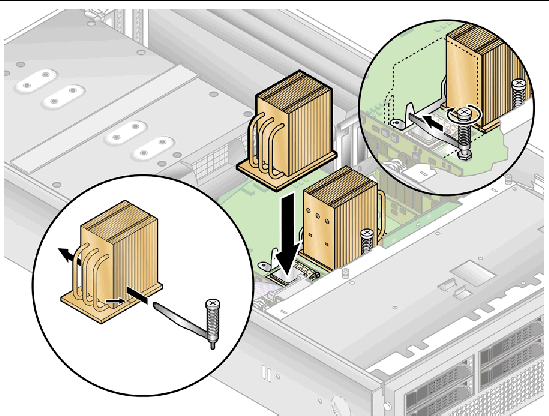
1. Power off the server, including any attached peripherals, and disconnect the server from the electrical outlet. If your server includes two power supplies, ensure that both power cords are disconnected from the electrical outlet.
Refer to Section 4.2, Powering Off the Server and Removing the Cover.
You do not need to remove the cover for this procedure.
2. Remove the front bezel from the server by pressing in on the rubberized buttons on each side of the bezel, then swinging the bezel top downward (see FIGURE 4-13).
3. Open the CPU card door, which is located under the hard drive bays, to access the CPU card. Press in the two buttons on the door and swing it downward so that it is open 180 degrees from the closed position (see FIGURE 4-14).
4. Open the two plastic levers on the CPU card corners simultaneously to release it from its backplane, then carefully pull it out of the server (see FIGURE 4-15).
5. Set the CPU card on an ESD-resistant surface.
6. Unscrew the heat sink from the motherboard.
a. Unfasten the two securing screws and remove the heat sink securing clip. See FIGURE 4-32.
a. Loosen the screws evenly on each side of the heat sink.
b. Remove the screws and captive springs that secure the heat sink (the washers remain fixed to the surface of the heat sink).
c. See and go to Section 4.5.13.3, Installing the Heat Sink Into the Updated Release (chassis PN 380-1206).
FIGURE 4-32 Removing the Securing Clip and Heat Sink for Stepping Versions “C0” and “CG” CPUs
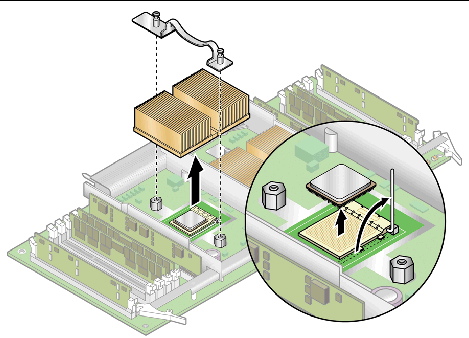
FIGURE 4-33 Heat Sink Secured With Spring Assembly for Stepping Version “E” CPU


|
Caution - The heat sink can become extremely hot. Ensure that it has had sufficient time to cool before handling. |
7. Twist the heat sink slightly to the right or left to break the seal with the thermal grease.
8. Lift the heat sink away from the CPU.
9. Use an alcohol pad to remove all thermal grease from the bottom of the heat sink.
Be careful not to get any thermal grease on your fingers. It is very sticky and you may contaminate other components when handling them.
10. Place the heat sink upsidedown on a flat surface to prevent the thermal grease from contaminating other components.
11. Pull the socket release lever up to the fully open, perpendicular position (see FIGURE 4-32).
12. Lift the CPU out of the socket, leaving the release lever in the open position.

|
Caution - Ensure that any thermal grease that might remain from the heat sink does not come into contact with the CPU socket or pins. |
1. Use the syringe from your Processor Replacement Kit to apply approximately 0.2 ML/CC of the thermal grease, in a circular pattern, to the top of the processor case. (Each drop of thermal grease consists of approximately 0.05 ML/CC.)
2. Use the plastic card from your Processor Replacement Kit to distribute the grease carefully. Scrape off any excess grease until only an extremely thin and uniform layer remains.
Any voids or crevices can create air pockets, so ensure that coverage is thin but thorough.
3. Carefully position the heat sink on the processor. Align the holes on either side of the heat sink over the mounting posts for the spring nuts. Ensure that both heat sink holes are centered over their respective mounting posts (see FIGURE 4-34).
4. Place the spring nut washers over the heat sink holes, and ensure that they also are centered over their respective standoffs (or mounting posts).
FIGURE 4-34 Type B Spring Assembly (With Threads on Standoff)

5. Carefully press down firmly and evenly on the heat sink, to hold it securely in place while you install the spring nuts.
| Note - Continue to press down on the heat sink until you complete Step 7. |
6. Place the rear spring nut (the one nearest the PCI support post) over the rear mounting post, and without using a tool, hand-tighten the spring nut as far as it allows.

|
Caution - Do not use a tool to tighten the spring nut. Using a tool might cause cross-threading. |
7. While still pressing down firmly and evenly on the heat sink, place the front spring nut over the front mounting post, and hand-tighten it as far as the spring nut allows.
| Note - After both spring nuts have been hand-tightened, you can release the downward pressure you applied on the heat sink. |
8. To ensure that the spring nuts are centered in the holes, grasp the top of the heat sink and gently rotate it, both left and right, to allow the spring nuts to center into the holes.
9. After you rotate the heat sink, hand-tighten the nuts again (use no other tools) to ensure that the springs are snug against the washers and the heat sink.
10. Attempt to rotate the heat sink again. You should notice only a small amount of side play if the spring nuts are fully centered in the holes.
11. Lightly hold the heat sink in place as you complete the installation:

|
Caution - Do not use a tool to tighten the spring nut. Using a tool might cause cross-threading. |
a. Tighten the rear spring nut three turns.
b. Tighten the front spring nut three turns.
c. Continue to alternate the tightening of the rear and front spring nuts until both spring nuts “bottom out” on the mounting posts.

|
Caution - Observe the appropriate ESD precautions. |
2. Ensure that the CPU socket release lever is in the fully open, perpendicular position (see FIGURE 4-35).
3. Align the small triangle on the corner of the CPU with the triangle on the corner of the socket.
FIGURE 4-35 Installing a CPU Into Its Socket

4. Insert the CPU into the socket.
5. When the CPU is fully seated in the socket, rotate the socket release lever down until it snaps into place, securing the CPU in the socket.
6. Use the syringe to apply approximately 0.2 ML/CC of thermal grease in a circular pattern to the top of the CPU. (Each drop of thermal grease consists of approximately 0.05 ML/CC.)
7. Gently distribute the thermal grease and remove any excess so that only an extremely thin, uniform layer remains. If any voids or crevices appear that could lead to air pockets, reapply the grease until you achieve a thin but compact consistency.
8. Inspect the heat sink for dust and lint. Clean again if necessary.
9. Ensure that the foam strip under the heat sink area is intact and has not been removed, loosened, or damaged. This foam strip is critical to proper airflow.
10. Carefully position the heat sink on the CPU, aligning it with the mounting posts to reduce movement after it makes initial contact with the layer of thermal grease.

|
Caution - If the heat sink is moved too much during its installation, the layer of thermal grease might become uneven, leading to component damage. |
11. After correctly aligning the heat sink, proceed according to the type of heat sink that you have:
a. Reinstall the heat sink clips so that the longer tab points toward the fans.
b. Tighten the clip-securing screws.

|
Caution - Tighten the screws evenly on each side of the heat sink. If you completely tighten the screw on one side first, you may damage the CPU underneath. |
a. Lightly hold the heat sink in place as you complete the installation.

|
Caution - Do not use a tool to tighten the spring nut. Using a tool might cause cross-threading. |
b. Tighten the rear spring nut three turns.
c. Tighten the front spring nut three turns.
d. Continue to alternate the tightening of the rear and front spring nuts until both spring nuts “bottom out” on the mounting posts.
a. Place the spring assembly washers over the heat sink holes, and ensure that they are also centered over their respective standoffs.
FIGURE 4-36 Type A Spring Assembly (With External Threads)

b. Carefully press down firmly and evenly on the heat sink, to hold it securely in place while you install the spring assemblies.
| Note - Continue to press down on the heat sink until you complete the step. |
c. Place the rear spring assembly (the one nearest the PCI support post) over the rear standoff, and without the use of any tools, hand-tighten it as far as the spring assembly allows.
d. While pressing down firmly and evenly on the heat sink, place the front spring assembly over the front standoff and hand-tighten it as far as the spring assembly allows.
e. After both spring assemblies have been hand-tightened, release the heat sink.
f. To ensure that the spring assemblies are centered in the holes, grasp the top of the heat sink and gently rotate it, both left and right, to allow the spring assemblies to center into the holes.
g. After you rotate the heat sink, hand-tighten the spring assemblies again (use no other tools) to ensure that they are snug against the washers and the heat sink.
h. Attempt to rotate the heat sink again. You should notice only a small amount of side play if the spring assemblies are fully centered in the holes.
i. Lightly hold the heat sink in place as you complete the installation with the appropriate tool.
j. Tighten the rear spring assembly three turns.
k. Tighten the front spring assembly three turns.
l. Continue to alternate the tightening of the rear and front spring assemblies until both spring assemblies “bottom out” on the standoffs.
12. Replace the CPU card into the server (see FIGURE 4-16):
a. Carefully align the rear corners of the CPU card with the plastic alignment tracks inside the server chassis, then slide the CPU card into the tracks.
b. Press in firmly and evenly on both corners of the CPU card until it engages the backplane.
c. Lock down the two plastic latches on the corners of the CPU card to secure it in place.
14. Replace the front bezel onto the server.
The system battery is a common CR2032 calculator battery.
You might need to replace the system battery if you know it is weak or if after any period of AC power loss, the BIOS loses its CMOS settings or if the time-of-day clock loses time.

|
Caution - Do not attempt to open or service batteries. The battery contains lithium and can explode if not properly used, handled or disposed of. |
1. Power off the server, including any attached peripherals, and disconnect the server from the electrical outlet. If your server includes two power supplies, ensure that both power cords are disconnected from the electrical outlet.
Refer to Section 4.2, Powering Off the Server and Removing the Cover.
2. Remove the top cover from the server.
3. Remove the power-supply cage assembly.
Refer to Section 4.5.9.2, Replacing a Power-Supply Cage Assembly.
4. Remove the system battery by sliding it back and prying it from the holder (see FIGURE 4-37 for the location).
FIGURE 4-37 Removing the System Battery
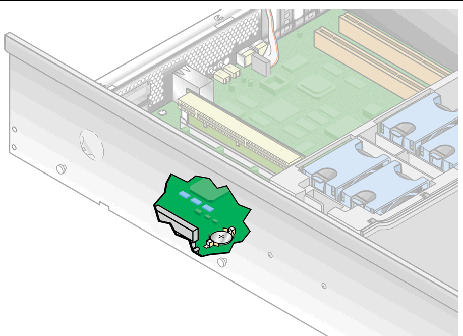
5. Install the new system battery into the holder with the side labeled “+” facing up.
| Note - Replace the battery only with the identical model. |
6. Reinstall the power-supply cage assembly.
Refer to Section 4.5.9.2, Replacing a Power-Supply Cage Assembly.
7. Before reinstalling the cover on the server, check the routing of all cables for obstructions.
The following procedure describes how to remove and replace the following cables:
The cable kit for the Sun Fire V40z server contains two SCSI signal cables:
| Note - To identify the version of your server, the chassis PN is labeled on the front panel of the server, by the DVD-ROM/diskette drive assembly. |
Depending on the cable that you want to replace, you need to remove various system components for access to the system cables.
For the operator-panel board cable, the internal USB cable and the DVD-ROM/diskette drive assembly cable, you should remove the following components:
For the SCSI backplane power cable and the SCSI signal cable, you should remove the following components:
Refer to the subsection in the procedures for the components to remove and for each type of system cable to replace.
Complete these steps first for all components that you are removing:
1. Power off the server, including any attached peripherals, and disconnect the server from the electrical outlet. If your server includes two power supplies, ensure that both power cords are disconnected from the electrical outlet.
Refer to Section 4.2, Powering Off the Server and Removing the Cover.
2. Remove the top cover from the server.
3. Remove the center air baffle (see FIGURE 4-18).
Lift the rear edge of the baffle, then move it toward the rear of the server to disengage the hooks on the front edge of the baffle.
1. Remove the rear fan-cage assembly. Squeeze inward the retainer clips on each end of the rear fan-cage assembly (see FIGURE 4-22).
2. Pull straight up on the fan-cage assembly to disengage it from the motherboard connector.
3. Lift the assembly up and out of the server.
1. Remove the individual power supplies. At the outside rear of the server, pull the finger ring on the power-supply handle toward you to disengage the power-supply connector from the power-distribution backplane (see FIGURE 4-23).
| Note - A twisted, plastic tie-wrap through the finger ring holds the power-supply handle in place. Untwist this tie-wrap to pull the handle out. |
2. Slide the power supply out of the power-supply cage and chassis.
1. Remove the power-supply cage assembly. Pull the metal handle on the top of the cage toward the front of the server so that the hinged cams lift the cage and disconnect it from the motherboard (see FIGURE 4-24).
2. Lift the front of the cage and disengage its metal tabs from their mounting holes on the server back panel to remove it from the chassis.
1. Remove any PCI option cards installed in the vertical slots, using one of the following two methods, depending on the type of slot from which you are removing the PCI card:
2. Remove the PCI option card.
Repeat Step 1 and Step 2 for each PCI option card installed in a vertical PCI slot.
 (Updated Release of V40z server only [chassis PN 380-1206]) A black plastic air-baffle cage has been added and replaces the individual air-baffle inserts.
(Updated Release of V40z server only [chassis PN 380-1206]) A black plastic air-baffle cage has been added and replaces the individual air-baffle inserts.
Remove the four screws that fasten the air-baffle cage to the motherboard, and remove the card cage.
You are now ready to remove and replace the system cables. Identify the cable to be replaced (see FIGURE 4-38 for the location).
FIGURE 4-38 System Cables in the Sun Fire V40z Server

Refer to FIGURE 4-39 for an illustration of the methods used to release cables from the various types of connectors.

|
Caution - Use caution when removing cables because connectors and pins are very fragile and can be damaged. |
FIGURE 4-39 Types of Cable Connector and Release Mechanisms
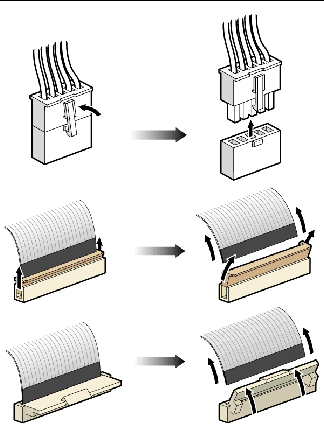
1. Disconnect the SCSI signal cable (1) from the SCSI backplane and from the motherboard.
2. Connect the new SCSI signal cable to the SCSI backplane and the motherboard, according to the markings on the cable.
If you have no other cables to replace, go to Section 4.5.15.4, Reinstalling System Components After Cable Installation. Otherwise, continue in the procedure with your next type of cable.
3. Disconnect the SCSI power cable (2) from the SCSI backplane and from the motherboard.
4. Connect the new SCSI power cable to the SCSI backplane and the motherboard, according to the markings on the cable.
If you have no other cables to replace, go to Section 4.5.15.4, Reinstalling System Components After Cable Installation. Otherwise, continue in the procedure with your next type of cable.
| Note - This cable consists of two separate cables for the signals that are joined at each end into one connector. |
1. Remove the metal PCI bracket guide. Unscrew the two screws that fasten the PCI bracket guide to the motherboard and server chassis. Lift the bracket guide up and out of the chassis.
This bracket guide keeps full-length PCI cards in place.
2. Slide the plastic air baffle up and off from the base of fan 12.
| Note - For the front fans, the fan numbers are imprinted on the center air baffle that normally sits on top of the front fan-cage assembly. |
3. Remove fan 12. Squeeze the retainer clip on the edge of the fan, then pull the fan straight up to disengage its connector and remove it from the fan cage.
4. Disconnect the DVD-ROM/diskette drive cable (3) from the motherboard (by the vertical PCI slots).
5. Remove the service loop for the flat cables from the plastic retainer clip on the chassis wall.
6. Press the plastic latch on the front left side of DVD-ROM/diskette drive assembly.
7. Gently pull the assembly out of the bay while feeding the cables through the rear of the bay (see FIGURE 4-12).
8. Disconnect the cables from the assembly.
9. Remove the cables from the bay and chassis.
10. Feed the new cables through the empty bay, with the end labeled “Motherboard” toward the rear of the chassis.
11. Connect the new cables to the assembly.
12. Slide the assembly back into the bay, while pulling the cables back into the chassis through the rear opening of the bay.
13. Push the assembly in until the latch clicks into the front panel.
14. Re-seat the service loop for the flat cables into the plastic retainer clip on the chassis wall.
If you have no other cables to replace, go to Repositioning the Cables. Otherwise, continue in the procedure with your next type of cable.
| Note - There are two separate cables that connect to the rear of the operator-panel board: the operator-panel cable and the USB cable. |
1. Remove the metal PCI bracket guide. Unscrew the two screws that fasten the PCI bracket guide to the motherboard and server chassis. Lift the bracket guide up and out of the chassis.
This bracket guide keeps full-length PCI cards in place.
2. Slide the plastic air baffle up and off from the base of fan 12.
| Note - For the front fans, the fan numbers are imprinted on the center air baffle that normally sits on top of the front fan-cage assembly. |
3. Remove fan 12. Squeeze the retainer clip on the edge of the fan, then pull the fan straight up to disengage its connector and remove it from the fan cage.
4. Disconnect the operator-panel cable (4) and the USB cable (5) from the motherboard (by the vertical PCI slots).
5. Remove the service loop for the flat cables from the plastic retainer clip on the chassis wall. Remove the USB cable from its plastic retainer clips.
6. Remove the screws that secure the operator-panel assembly in place.
There are two screws on top and one captive screw inside the chassis, just behind the assembly (see FIGURE 4-17).
7. Slide the operator-panel assembly through the front panel of the server.
8. Disconnect the operator-panel cable and the USB cable from the assembly.
9. Remove the cables from the chassis.
10. Feed the new cables through the opening in the front panel, with the ends of each cable labeled “Motherboard” toward the rear of the chassis.
11. Connect the new operator-panel cable and the USB cable to the assembly.
12. Slide the assembly into the opening, while pulling the cables back into the chassis.
13. Push the assembly in until the top screw holes line up.
14. With the three screws, reattach the assembly to the chassis.
15. Re-seat the service loop for the flat cables into the plastic retainer clip on the chassis wall.
16. Re-seat the USB cable in its plastic retainer clips on the wall.
If you have no other cables to replace, go to the next section on repositioning the cables. Otherwise, continue in the procedure with your next type of cable.
This section is for the operator-panel board cable, the internal USB cable, and the DVD-ROM/diskette drive assembly cable.

|
Caution - Ensure that you do not damage the memory voltage-regulator module (VRM) when you are reinstalling the PCI bracket guide. |
1. Lay the cables flat against the chassis wall, outside of the memory VRM on that side.
2. Connect the new cables to the motherboard.
3. Reinstall the PCI bracket guide in the chassis:
| Note - Ensure that you feed the USB cable through the notch. Do not feed it through any of the four large vertical PCI openings. |
4. With the two screws, reattach the PCI bracket guide to the chassis wall and to the motherboard. Do not tighten the screws yet.
5. While the bracket guide is loose, pull the excess cable length toward the open space next to the DVD-ROM bay and operator-panel assembly, at the front of the server.
Keep the cable flat along the chassis wall next to the memory VRM.
6. Tighten the two screws on the PCI bracket guide.
Refer to the relevant sections in these procedures to reinstall any other components that you removed.
Before reinstalling the components, check the routing of all cables for obstructions.
1. (Optional) If you removed fan 12, slide the plastic air baffle onto fan 12 and down to the base.
2. Align the fan with the bay in the fan cage and push down firmly and evenly on both top corners of the fan to engage it with the cage connector.
1. Reposition the air-baffle cage on the motherboard.
2. Reattach the air-baffle cage with the four screws.
1. Insert the new card into the slot. Push down evenly on both corners of the card to ensure that it is seated correctly.
2. Secure the PCI card using one of the following two methods:
1. Insert the power-supply case assembly into the chassis with the rear of the assembly angled downward and the assembly handle in the fully open position (see FIGURE 4-24).
2. Carefully insert the metal tabs on the rear of the assembly into their slots on the chassis back panel.
3. With the tabs in place, set the front of the assembly down on the motherboard connector.
4. Press the metal handle on the top of the assembly down until the connectors on the motherboard engage with the assembly backplane.
1. Open the power-supply handle to the fully open position (see FIGURE 4-23).
2. Insert the power supply into the power-supply cage and push the power supply inward until it stops at the backplane.
3. Push the power-supply handle closed until it locks into place.
 Align the fan cage with the chassis and push down on both ends of the fan cage until both retaining clips click securely into place and the fan-cage connector fully engages with the motherboard connector (see FIGURE 4-22).
Align the fan cage with the chassis and push down on both ends of the fan cage until both retaining clips click securely into place and the fan-cage connector fully engages with the motherboard connector (see FIGURE 4-22).
1. Replace the center air baffle (see FIGURE 4-18).
2. Before reinstalling the cover on the server, check the routing of all cables for obstructions.

|
Caution - Only a qualified technician is allowed to perform this procedure. This package is not a customer-replaceable unit (CRU). |
The Super FRU is a chassis containing the motherboard and certain customer-replaceable units (CRUs). To install a Super FRU, you must remove all of the CRUs from the old chassis. Then, reinstall each of those components in the new Super FRU chassis.
Refer to the Service Label, on the inside of the chassis cover, for the location of the components.
1. Power off the server, including any attached peripherals, and disconnect the server from the electrical outlet. If your server includes two power supplies, ensure that both power cords are disconnected from the electrical outlet.
Refer to Section 4.2, Powering Off the Server and Removing the Cover.
Some procedures might not require you to remove the cover. Refer to the individual instructions as indicated.
2. Remove the following components and transfer them to the new Super FRU chassis.
Refer to the appropriate instructions in this chapter to remove and replace each component. Also refer to FIGURE 4-2 for component locations.
3. Attach any peripherals and connect the power cord. If your server includes two power supplies, ensure that both power cords are connected.
Use this procedure after a Super FRU replacement if the sever fails to boot due to a PCI ID mismatch.
1. Boot the server using the Bootable Diagnostics CD. For instructions on using the Bootable Diagnostics CD, refer to the Bootable Diagnostics CD for the Sun Fire V20z and Sun Fire V40z Servers (819-1810).
2. Open a terminal window to access a command line.
# mount /dev/dsk/device name /a
4. If /usr directory is in a separate partition then mount it:
# mount /dev/dsk/device name /a/usr
chroot /a /usr/sbin/devfsadm -v
7. Write down the boot path. To obtain the boot path type:
For example: pci@0,0/pci1022,745@a/pci1000,1010@4/sd@0,0:a
8. Open the bootenv.rc file in a text editor.
For example: # vi /a/boot/solaris/bootenv.rc
9. Locate the boot path in the bootenv.rc file.
10. Edit the boot path, by replacing the old path with the path written down in Step 7.
11. Save the file and exit the editor.
12. Reboot the system, for example, by entering:
FIGURE 4-40 shows the locations of the activity indicator LEDs and the Clear-CMOS jumper on the motherboard and the optional CPU card. TABLE 4-6 defines the component to which each fault indicator LED corresponds.
Jumper J125, the Clear-CMOS jumper, is explained in Section 4.6.2, Clear-CMOS Jumper.
FIGURE 4-40 Sun Fire V40z Motherboard, Showing LED Locations
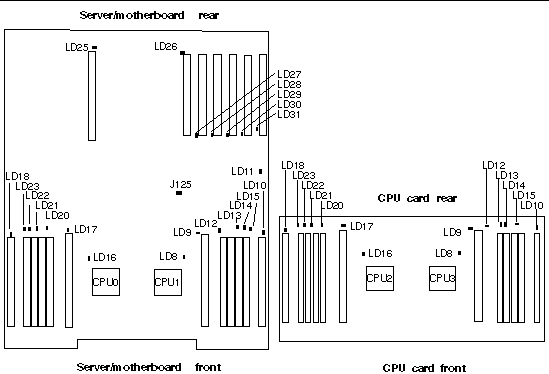
TABLE 4-6 defines the activity indicators that are shown in FIGURE 4-40. The LED numbers are intentionally duplicated between the motherboard and the CPU card.
All other jumpers and switches are for internal factory troubleshooting and are intentionally not documented in this guide.
The location of the Clear-CMOS jumper (J125) on the Sun Fire V40z motherboard is shown in FIGURE 4-41. This jumper can be used to clear the CMOS if the server hangs during certain conditions.
FIGURE 4-41 Sun Fire V40z Motherboard, Showing Clear-CMOS Jumper J125

Copyright © 2008, Sun Microsystems, Inc. All Rights Reserved.